LTR Housing: Data Silos, Internal Communication, & Email Project
VerifiedAdded on 2023/01/12
|10
|3048
|53
Report
AI Summary
This report examines the operational and project management challenges faced by Luton Town Residences (LTR), a housing association. It identifies data silos within different functional teams, including finance, facilities maintenance, and supported housing, highlighting the limitations of their current data management and sharing practices. The report analyzes LTR's internal communication, which primarily relies on email, leading to missed information and delays. To address these issues, the report proposes an email replacement project and presents a business case for implementing alternative communication tools like ERP systems, Yammer, Facebook for Work, and Skype. The business case outlines the reasons for the project, explores business options, forecasts expected benefits such as increased collaboration and resident satisfaction, and addresses potential risks. The report aims to provide LTR with insights and recommendations for improving its internal communication, data management, and overall operational efficiency.
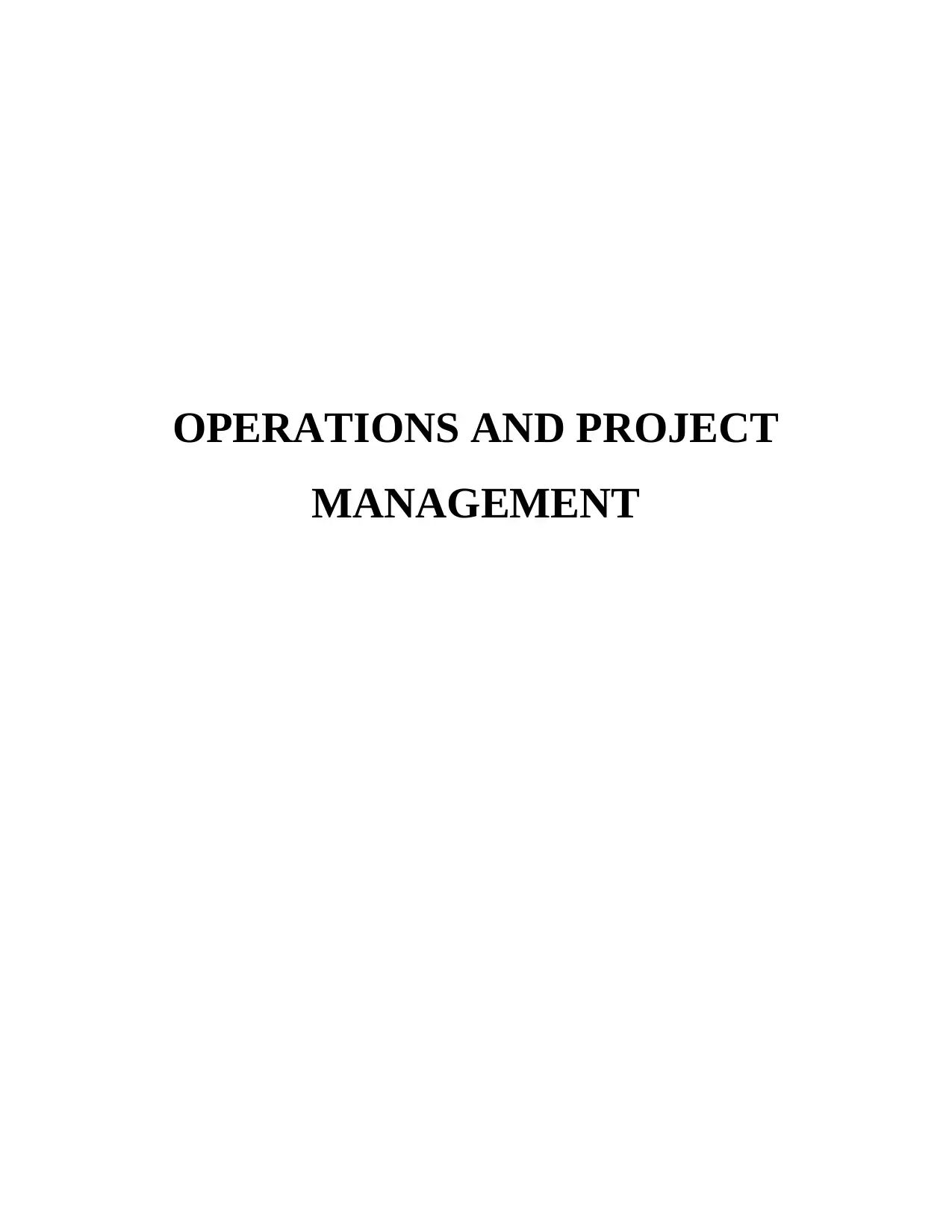
OPERATIONS AND PROJECT
MANAGEMENT
MANAGEMENT
Paraphrase This Document
Need a fresh take? Get an instant paraphrase of this document with our AI Paraphraser
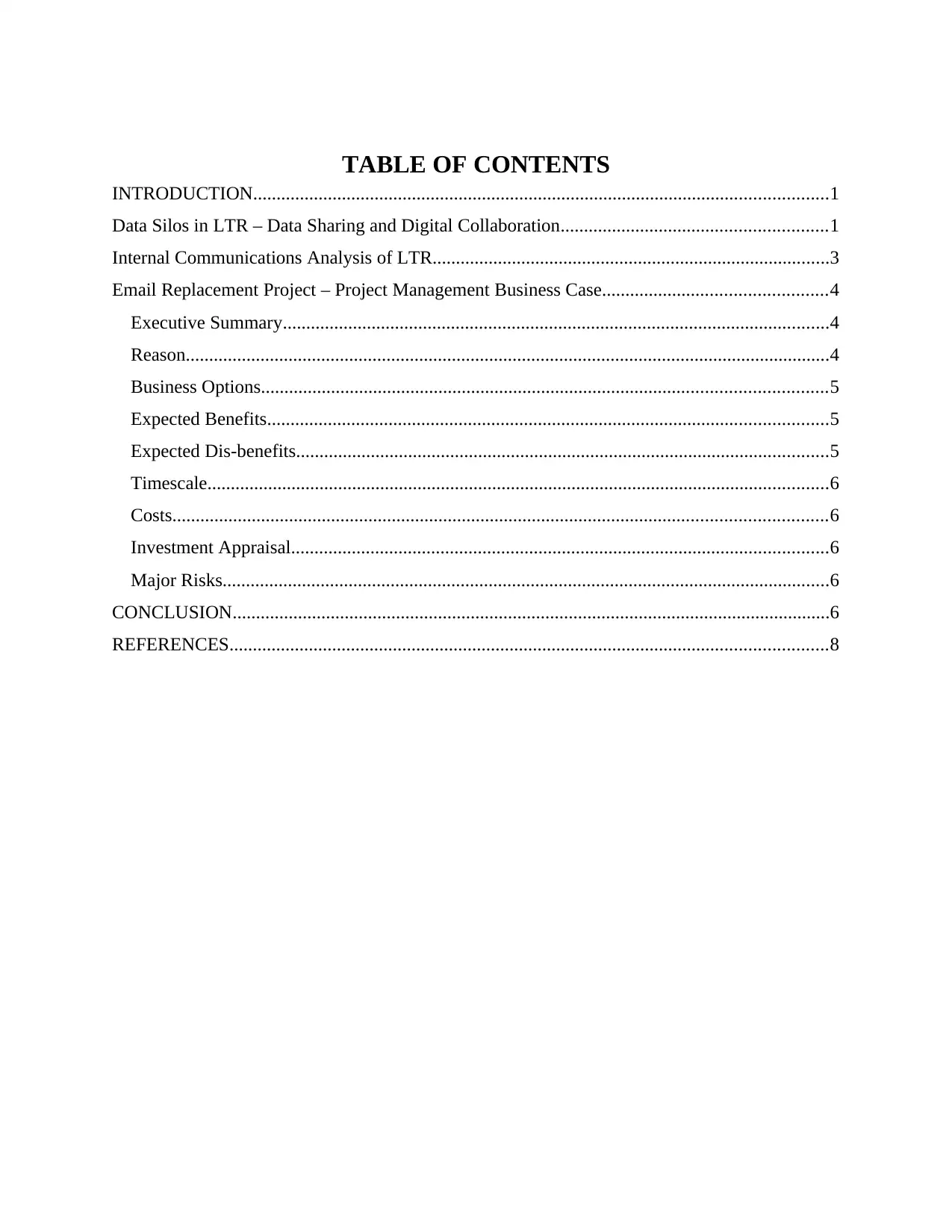
TABLE OF CONTENTS
INTRODUCTION...........................................................................................................................1
Data Silos in LTR – Data Sharing and Digital Collaboration.........................................................1
Internal Communications Analysis of LTR.....................................................................................3
Email Replacement Project – Project Management Business Case................................................4
Executive Summary.....................................................................................................................4
Reason..........................................................................................................................................4
Business Options.........................................................................................................................5
Expected Benefits........................................................................................................................5
Expected Dis-benefits..................................................................................................................5
Timescale.....................................................................................................................................6
Costs............................................................................................................................................6
Investment Appraisal...................................................................................................................6
Major Risks..................................................................................................................................6
CONCLUSION................................................................................................................................6
REFERENCES................................................................................................................................8
INTRODUCTION...........................................................................................................................1
Data Silos in LTR – Data Sharing and Digital Collaboration.........................................................1
Internal Communications Analysis of LTR.....................................................................................3
Email Replacement Project – Project Management Business Case................................................4
Executive Summary.....................................................................................................................4
Reason..........................................................................................................................................4
Business Options.........................................................................................................................5
Expected Benefits........................................................................................................................5
Expected Dis-benefits..................................................................................................................5
Timescale.....................................................................................................................................6
Costs............................................................................................................................................6
Investment Appraisal...................................................................................................................6
Major Risks..................................................................................................................................6
CONCLUSION................................................................................................................................6
REFERENCES................................................................................................................................8

INTRODUCTION
Project and operation management are two most important part that are required to be
focused on by the organizations. Operation management within an organization deals with day to
day strategic business issues in a systematic order. Whereas project management deals with
organizing, planning, controlling and motivating all the resources of business in order to achieve
specific goals (Cooren and Seidl, 2019). This assignment will focus on a case study of LTR also
known as Luton Town Residences is a Housing Association that operates in Luton. They focus
on providing housing to local community with one focus i.e. to provide support and assistance to
vulnerable individuals. They do not have a centralized system that can be used by all the
members of the organization. Each team of the organization have their own segregated data and
share required information though emails. This assignment will focus on Data Silos in LTR,
internal communication analysis of Luton Town Residences Housing Association and business
case of email replacement.
Data Silos in LTR – Data Sharing and Digital Collaboration
Data Silos can be defined as a fixed data repository that remains under the control of one
department and is completely isolated from rest of the organization. It is a kind of segregated
data which is stored in multiple enterprise application (Wilder-James, 2016). Data silos restricts
information and collaboration among teams which can further lead to poor decision making and
can impact profitability negatively and can also affect accuracy of data or information stored
within the organization. Data Silos often increases overall organizational cost of data
management and collaboration and many times often leads to internal issues or delay in passing
important information further. Implementation and usage of Data Silos increases cost of
extracting data for other uses (Patel, 2019). In the given case study, there are various kinds of
Data Silos that are used by LTR which is a housing association in Luton. LTR manages manage
several distinct housing blocks that are divided into two types of housing: General Purpose
Housing and Supported Housing. They do not have their own centralized system in which their
can store their data, manage or extract it for future use. They have different functional teams that
tracks or manages issues within their own, specific areas. Each of the team have their own
separate system which is used by them to track or retain information within their respective
functional area (Suominen and Hyvönen, 2017). From the given case study, three different data
Silos have been identified that are used by different teams of LTR housing association. Both the
1
Project and operation management are two most important part that are required to be
focused on by the organizations. Operation management within an organization deals with day to
day strategic business issues in a systematic order. Whereas project management deals with
organizing, planning, controlling and motivating all the resources of business in order to achieve
specific goals (Cooren and Seidl, 2019). This assignment will focus on a case study of LTR also
known as Luton Town Residences is a Housing Association that operates in Luton. They focus
on providing housing to local community with one focus i.e. to provide support and assistance to
vulnerable individuals. They do not have a centralized system that can be used by all the
members of the organization. Each team of the organization have their own segregated data and
share required information though emails. This assignment will focus on Data Silos in LTR,
internal communication analysis of Luton Town Residences Housing Association and business
case of email replacement.
Data Silos in LTR – Data Sharing and Digital Collaboration
Data Silos can be defined as a fixed data repository that remains under the control of one
department and is completely isolated from rest of the organization. It is a kind of segregated
data which is stored in multiple enterprise application (Wilder-James, 2016). Data silos restricts
information and collaboration among teams which can further lead to poor decision making and
can impact profitability negatively and can also affect accuracy of data or information stored
within the organization. Data Silos often increases overall organizational cost of data
management and collaboration and many times often leads to internal issues or delay in passing
important information further. Implementation and usage of Data Silos increases cost of
extracting data for other uses (Patel, 2019). In the given case study, there are various kinds of
Data Silos that are used by LTR which is a housing association in Luton. LTR manages manage
several distinct housing blocks that are divided into two types of housing: General Purpose
Housing and Supported Housing. They do not have their own centralized system in which their
can store their data, manage or extract it for future use. They have different functional teams that
tracks or manages issues within their own, specific areas. Each of the team have their own
separate system which is used by them to track or retain information within their respective
functional area (Suominen and Hyvönen, 2017). From the given case study, three different data
Silos have been identified that are used by different teams of LTR housing association. Both the
1
⊘ This is a preview!⊘
Do you want full access?
Subscribe today to unlock all pages.

Trusted by 1+ million students worldwide

types of housing have their own separate Data silos that are used by their functional teams for
management of facilities. However, customer services team simply uses Excel Sheets, word or
text documents for storing information and resolving issues of individual residents.
First data Silo identified is Share Point server or Share point Drive This Data Silo is used by
Finance team for access and version control for key financial documents. This Share Point
drive can only be accessed by finance team and other than finance team it can only be
accessed by restricted number of non-authorised employees. This drive is managed centrally
but cannot accessed by everyone. People who have restricted access to this drive can only
access it. All kinds of finance excel sheet or word document of finance department are stored
in this drive. These financial sheets can be shared with any member of finance team. Other
then them access to this drive is restricted.
Another data Silo identified is 360Facility which is a special cloud-based system. This
system is specifically used by facilities maintenance team for management of all kinds of
facilities within their functional area. No other member, other than Facilities maintenance
team have access to this cloud-based system. All the information related to facilities
management is directly stored and shared with other members of facilities management
teams through this cloud-based system only.
Last Data silo identified is company laptops that are used by Personal Coach of Supported
Housing department. These personal coaches store all kinds of personal and sensitive
information about their residents within a password protected word document that are stored
within companies’ laptops. These laptops and sensitive information stored within it can only
be accessed by personal coaches and other than them Supported Housing Team Leader can
access these laptops or information stored within it. Back up of all the information stored
within these laptops is taken on regular basis within a secure hard drive. This hard drive is
securely sept in a locked room of main Luton Town Centre office.
There are the three main types of data Silos that have been identified and used by
functional teams of LTR housing association. These Data Silos helps functional teams of
LTR to store and protect information. If any of these teams want to collaborate with each
other or want to share any information with other teams then they cannot provide access of
these Data Silos to other teams in order to share data or collaborate with other functional
2
management of facilities. However, customer services team simply uses Excel Sheets, word or
text documents for storing information and resolving issues of individual residents.
First data Silo identified is Share Point server or Share point Drive This Data Silo is used by
Finance team for access and version control for key financial documents. This Share Point
drive can only be accessed by finance team and other than finance team it can only be
accessed by restricted number of non-authorised employees. This drive is managed centrally
but cannot accessed by everyone. People who have restricted access to this drive can only
access it. All kinds of finance excel sheet or word document of finance department are stored
in this drive. These financial sheets can be shared with any member of finance team. Other
then them access to this drive is restricted.
Another data Silo identified is 360Facility which is a special cloud-based system. This
system is specifically used by facilities maintenance team for management of all kinds of
facilities within their functional area. No other member, other than Facilities maintenance
team have access to this cloud-based system. All the information related to facilities
management is directly stored and shared with other members of facilities management
teams through this cloud-based system only.
Last Data silo identified is company laptops that are used by Personal Coach of Supported
Housing department. These personal coaches store all kinds of personal and sensitive
information about their residents within a password protected word document that are stored
within companies’ laptops. These laptops and sensitive information stored within it can only
be accessed by personal coaches and other than them Supported Housing Team Leader can
access these laptops or information stored within it. Back up of all the information stored
within these laptops is taken on regular basis within a secure hard drive. This hard drive is
securely sept in a locked room of main Luton Town Centre office.
There are the three main types of data Silos that have been identified and used by
functional teams of LTR housing association. These Data Silos helps functional teams of
LTR to store and protect information. If any of these teams want to collaborate with each
other or want to share any information with other teams then they cannot provide access of
these Data Silos to other teams in order to share data or collaborate with other functional
2
Paraphrase This Document
Need a fresh take? Get an instant paraphrase of this document with our AI Paraphraser

teams Email is used within LTR. With the help of Emails customer service team send issues
of residents related to respective functional team.
Internal Communications Analysis of LTR
In LTR all kinds of communications currently take place with the help of emails only. All
the functional teams communicate with each other with the help of emails. If any information is
required to be speeded organization wide then it is also shared with the help of emails only with
the help of daily newsletters (Rai, 2016). These newsletters are shared with each employee
through email. But because of this current communication channel most of the time important
information is missed or ignored by employees. In order to reduce this issue managers, send
daily reminder letters to their employees after the news letter has been distributed. Many times,
other functional teams do not respond to emails of customer service team because of which
residents have to wait for several days for their issue to be resolved (Reda, Piccinini and
Carbonaro, 2018). So, it can be said that there are various kinds of issues within current internal
communication of LTR which is less time consuming and communication through which can be
done easily. It is extremely important for LTR to adopt new technology that can be used by them
for effective communication. Here are different types of technologies that can be used as an
alternative to Email.
ERP: A fully integrated Enterprise resource planning software is one of the most effective
and useful tools that can be used to improve internal communication. Entire organizations
should one system to store data that means every one would be working with exact set of
information. If one employees of a team change any information or data within the system
then that information would be made available to every other employee as well. ERP is one
of the most effective solution that can be used as an alternative for Emails within LTR. LTR
can implement ERP system within their organization which will help them to improve their
internal communication. This software can also be used for analysis as well in which reports
can be generated and shared with other teams of the organization customer service team can
generate a report of resident issues and can share it with other teams so that they can work on
resolving those issues (Nwata, Umoh and Amah, 2016). It will help the organization to
enhance their communication among all the employees.
Enterprise social networking service such as Yammer can also be used by LTR as an
alternative for emails. Yammer is a social networking site that provides a platform for
3
of residents related to respective functional team.
Internal Communications Analysis of LTR
In LTR all kinds of communications currently take place with the help of emails only. All
the functional teams communicate with each other with the help of emails. If any information is
required to be speeded organization wide then it is also shared with the help of emails only with
the help of daily newsletters (Rai, 2016). These newsletters are shared with each employee
through email. But because of this current communication channel most of the time important
information is missed or ignored by employees. In order to reduce this issue managers, send
daily reminder letters to their employees after the news letter has been distributed. Many times,
other functional teams do not respond to emails of customer service team because of which
residents have to wait for several days for their issue to be resolved (Reda, Piccinini and
Carbonaro, 2018). So, it can be said that there are various kinds of issues within current internal
communication of LTR which is less time consuming and communication through which can be
done easily. It is extremely important for LTR to adopt new technology that can be used by them
for effective communication. Here are different types of technologies that can be used as an
alternative to Email.
ERP: A fully integrated Enterprise resource planning software is one of the most effective
and useful tools that can be used to improve internal communication. Entire organizations
should one system to store data that means every one would be working with exact set of
information. If one employees of a team change any information or data within the system
then that information would be made available to every other employee as well. ERP is one
of the most effective solution that can be used as an alternative for Emails within LTR. LTR
can implement ERP system within their organization which will help them to improve their
internal communication. This software can also be used for analysis as well in which reports
can be generated and shared with other teams of the organization customer service team can
generate a report of resident issues and can share it with other teams so that they can work on
resolving those issues (Nwata, Umoh and Amah, 2016). It will help the organization to
enhance their communication among all the employees.
Enterprise social networking service such as Yammer can also be used by LTR as an
alternative for emails. Yammer is a social networking site that provides a platform for
3
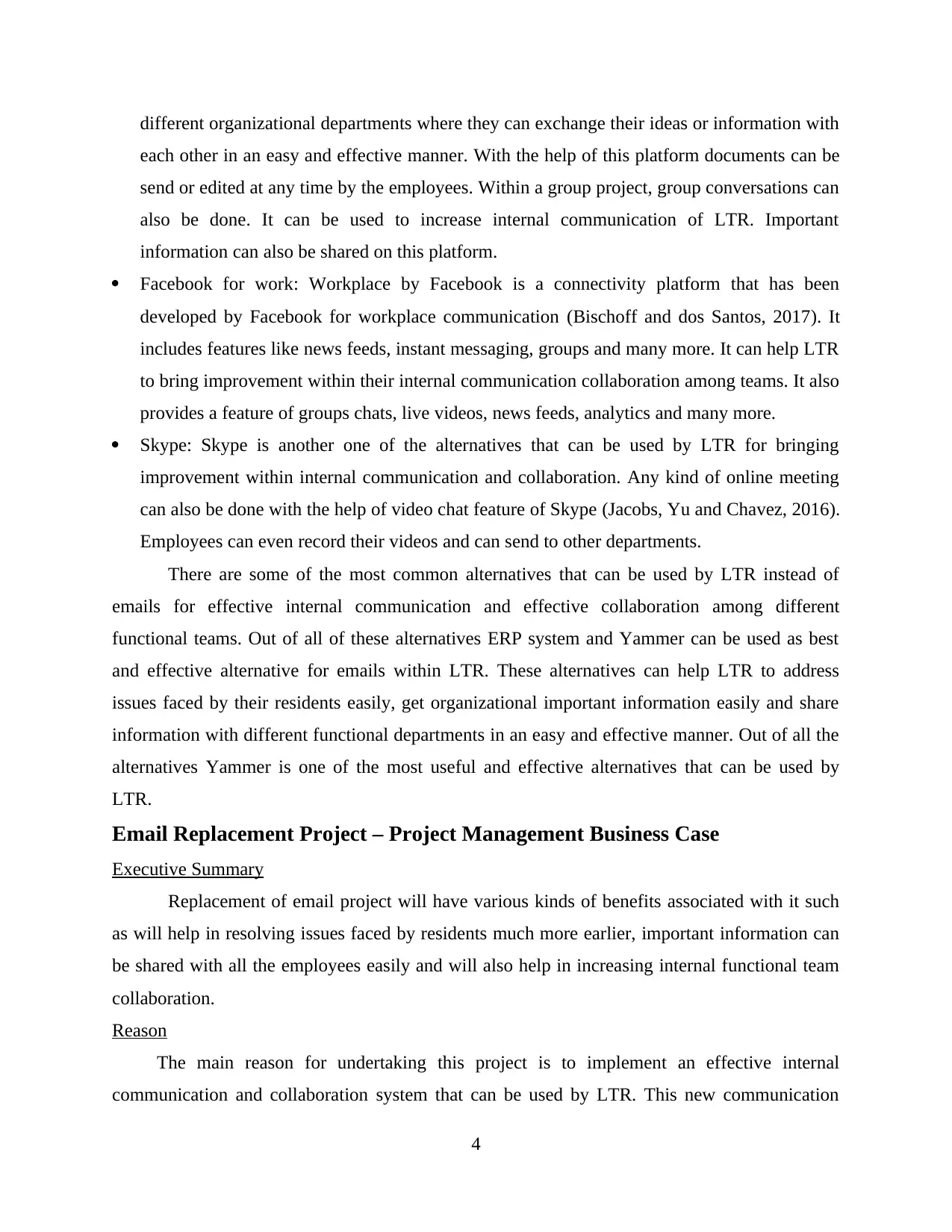
different organizational departments where they can exchange their ideas or information with
each other in an easy and effective manner. With the help of this platform documents can be
send or edited at any time by the employees. Within a group project, group conversations can
also be done. It can be used to increase internal communication of LTR. Important
information can also be shared on this platform.
Facebook for work: Workplace by Facebook is a connectivity platform that has been
developed by Facebook for workplace communication (Bischoff and dos Santos, 2017). It
includes features like news feeds, instant messaging, groups and many more. It can help LTR
to bring improvement within their internal communication collaboration among teams. It also
provides a feature of groups chats, live videos, news feeds, analytics and many more.
Skype: Skype is another one of the alternatives that can be used by LTR for bringing
improvement within internal communication and collaboration. Any kind of online meeting
can also be done with the help of video chat feature of Skype (Jacobs, Yu and Chavez, 2016).
Employees can even record their videos and can send to other departments.
There are some of the most common alternatives that can be used by LTR instead of
emails for effective internal communication and effective collaboration among different
functional teams. Out of all of these alternatives ERP system and Yammer can be used as best
and effective alternative for emails within LTR. These alternatives can help LTR to address
issues faced by their residents easily, get organizational important information easily and share
information with different functional departments in an easy and effective manner. Out of all the
alternatives Yammer is one of the most useful and effective alternatives that can be used by
LTR.
Email Replacement Project – Project Management Business Case
Executive Summary
Replacement of email project will have various kinds of benefits associated with it such
as will help in resolving issues faced by residents much more earlier, important information can
be shared with all the employees easily and will also help in increasing internal functional team
collaboration.
Reason
The main reason for undertaking this project is to implement an effective internal
communication and collaboration system that can be used by LTR. This new communication
4
each other in an easy and effective manner. With the help of this platform documents can be
send or edited at any time by the employees. Within a group project, group conversations can
also be done. It can be used to increase internal communication of LTR. Important
information can also be shared on this platform.
Facebook for work: Workplace by Facebook is a connectivity platform that has been
developed by Facebook for workplace communication (Bischoff and dos Santos, 2017). It
includes features like news feeds, instant messaging, groups and many more. It can help LTR
to bring improvement within their internal communication collaboration among teams. It also
provides a feature of groups chats, live videos, news feeds, analytics and many more.
Skype: Skype is another one of the alternatives that can be used by LTR for bringing
improvement within internal communication and collaboration. Any kind of online meeting
can also be done with the help of video chat feature of Skype (Jacobs, Yu and Chavez, 2016).
Employees can even record their videos and can send to other departments.
There are some of the most common alternatives that can be used by LTR instead of
emails for effective internal communication and effective collaboration among different
functional teams. Out of all of these alternatives ERP system and Yammer can be used as best
and effective alternative for emails within LTR. These alternatives can help LTR to address
issues faced by their residents easily, get organizational important information easily and share
information with different functional departments in an easy and effective manner. Out of all the
alternatives Yammer is one of the most useful and effective alternatives that can be used by
LTR.
Email Replacement Project – Project Management Business Case
Executive Summary
Replacement of email project will have various kinds of benefits associated with it such
as will help in resolving issues faced by residents much more earlier, important information can
be shared with all the employees easily and will also help in increasing internal functional team
collaboration.
Reason
The main reason for undertaking this project is to implement an effective internal
communication and collaboration system that can be used by LTR. This new communication
4
⊘ This is a preview!⊘
Do you want full access?
Subscribe today to unlock all pages.

Trusted by 1+ million students worldwide
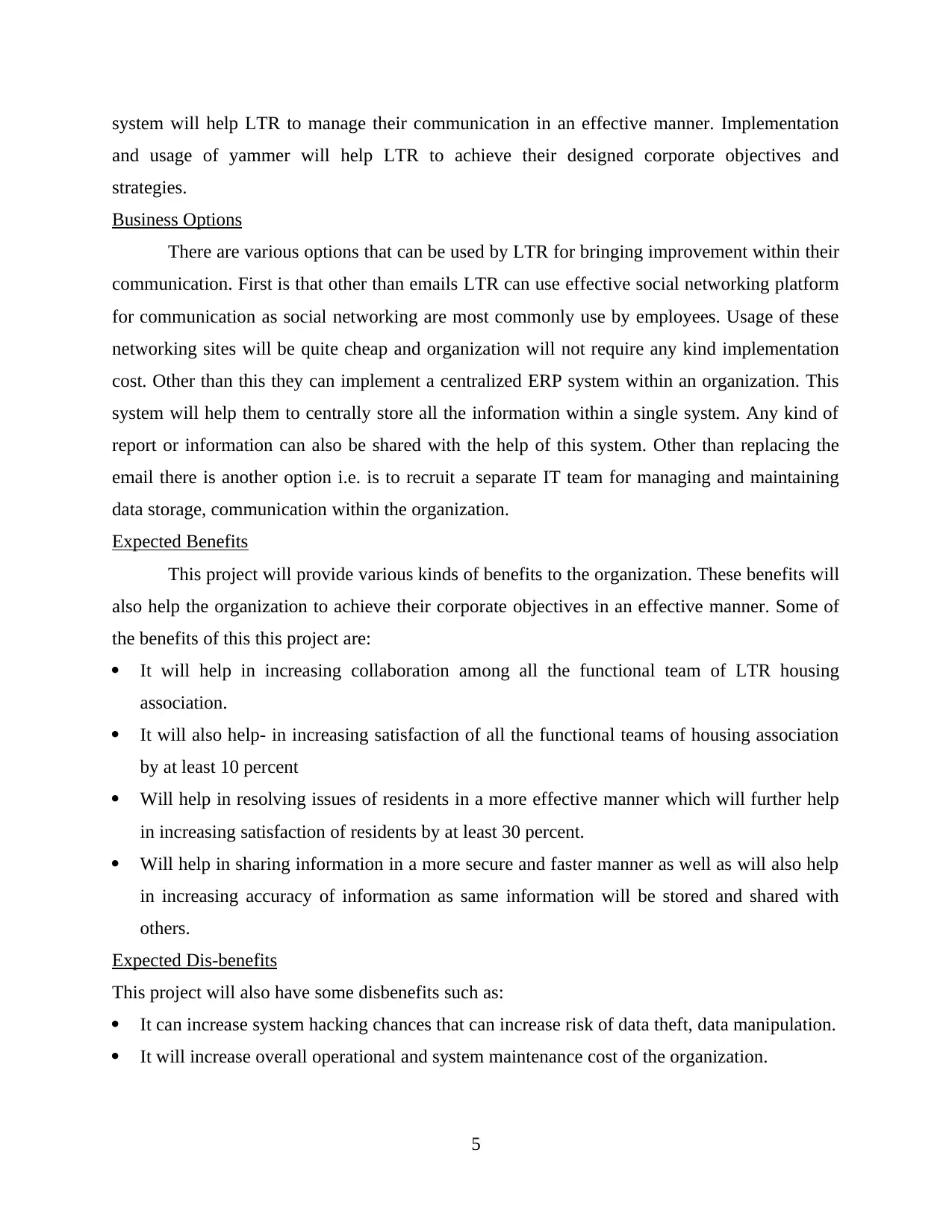
system will help LTR to manage their communication in an effective manner. Implementation
and usage of yammer will help LTR to achieve their designed corporate objectives and
strategies.
Business Options
There are various options that can be used by LTR for bringing improvement within their
communication. First is that other than emails LTR can use effective social networking platform
for communication as social networking are most commonly use by employees. Usage of these
networking sites will be quite cheap and organization will not require any kind implementation
cost. Other than this they can implement a centralized ERP system within an organization. This
system will help them to centrally store all the information within a single system. Any kind of
report or information can also be shared with the help of this system. Other than replacing the
email there is another option i.e. is to recruit a separate IT team for managing and maintaining
data storage, communication within the organization.
Expected Benefits
This project will provide various kinds of benefits to the organization. These benefits will
also help the organization to achieve their corporate objectives in an effective manner. Some of
the benefits of this this project are:
It will help in increasing collaboration among all the functional team of LTR housing
association.
It will also help- in increasing satisfaction of all the functional teams of housing association
by at least 10 percent
Will help in resolving issues of residents in a more effective manner which will further help
in increasing satisfaction of residents by at least 30 percent.
Will help in sharing information in a more secure and faster manner as well as will also help
in increasing accuracy of information as same information will be stored and shared with
others.
Expected Dis-benefits
This project will also have some disbenefits such as:
It can increase system hacking chances that can increase risk of data theft, data manipulation.
It will increase overall operational and system maintenance cost of the organization.
5
and usage of yammer will help LTR to achieve their designed corporate objectives and
strategies.
Business Options
There are various options that can be used by LTR for bringing improvement within their
communication. First is that other than emails LTR can use effective social networking platform
for communication as social networking are most commonly use by employees. Usage of these
networking sites will be quite cheap and organization will not require any kind implementation
cost. Other than this they can implement a centralized ERP system within an organization. This
system will help them to centrally store all the information within a single system. Any kind of
report or information can also be shared with the help of this system. Other than replacing the
email there is another option i.e. is to recruit a separate IT team for managing and maintaining
data storage, communication within the organization.
Expected Benefits
This project will provide various kinds of benefits to the organization. These benefits will
also help the organization to achieve their corporate objectives in an effective manner. Some of
the benefits of this this project are:
It will help in increasing collaboration among all the functional team of LTR housing
association.
It will also help- in increasing satisfaction of all the functional teams of housing association
by at least 10 percent
Will help in resolving issues of residents in a more effective manner which will further help
in increasing satisfaction of residents by at least 30 percent.
Will help in sharing information in a more secure and faster manner as well as will also help
in increasing accuracy of information as same information will be stored and shared with
others.
Expected Dis-benefits
This project will also have some disbenefits such as:
It can increase system hacking chances that can increase risk of data theft, data manipulation.
It will increase overall operational and system maintenance cost of the organization.
5
Paraphrase This Document
Need a fresh take? Get an instant paraphrase of this document with our AI Paraphraser
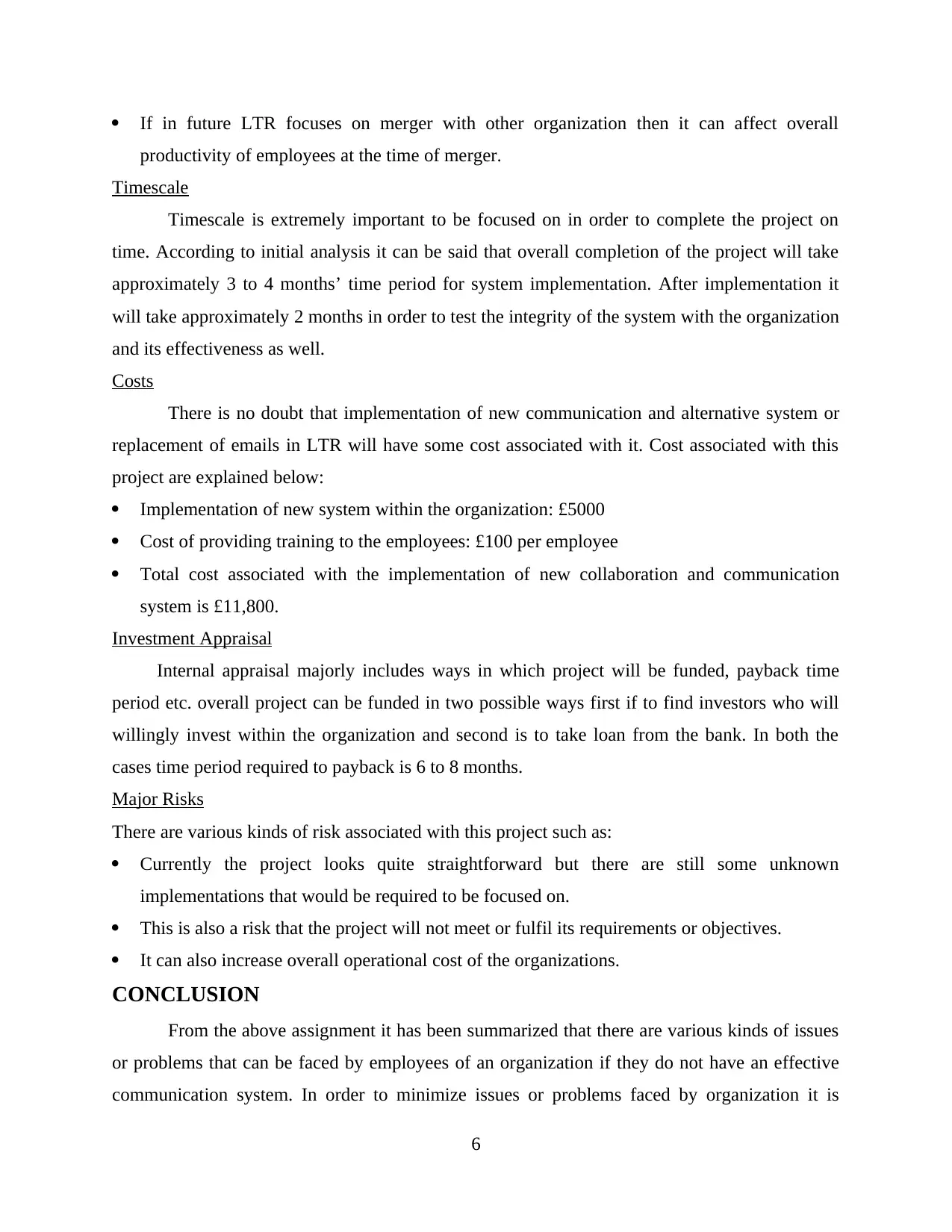
If in future LTR focuses on merger with other organization then it can affect overall
productivity of employees at the time of merger.
Timescale
Timescale is extremely important to be focused on in order to complete the project on
time. According to initial analysis it can be said that overall completion of the project will take
approximately 3 to 4 months’ time period for system implementation. After implementation it
will take approximately 2 months in order to test the integrity of the system with the organization
and its effectiveness as well.
Costs
There is no doubt that implementation of new communication and alternative system or
replacement of emails in LTR will have some cost associated with it. Cost associated with this
project are explained below:
Implementation of new system within the organization: £5000
Cost of providing training to the employees: £100 per employee
Total cost associated with the implementation of new collaboration and communication
system is £11,800.
Investment Appraisal
Internal appraisal majorly includes ways in which project will be funded, payback time
period etc. overall project can be funded in two possible ways first if to find investors who will
willingly invest within the organization and second is to take loan from the bank. In both the
cases time period required to payback is 6 to 8 months.
Major Risks
There are various kinds of risk associated with this project such as:
Currently the project looks quite straightforward but there are still some unknown
implementations that would be required to be focused on.
This is also a risk that the project will not meet or fulfil its requirements or objectives.
It can also increase overall operational cost of the organizations.
CONCLUSION
From the above assignment it has been summarized that there are various kinds of issues
or problems that can be faced by employees of an organization if they do not have an effective
communication system. In order to minimize issues or problems faced by organization it is
6
productivity of employees at the time of merger.
Timescale
Timescale is extremely important to be focused on in order to complete the project on
time. According to initial analysis it can be said that overall completion of the project will take
approximately 3 to 4 months’ time period for system implementation. After implementation it
will take approximately 2 months in order to test the integrity of the system with the organization
and its effectiveness as well.
Costs
There is no doubt that implementation of new communication and alternative system or
replacement of emails in LTR will have some cost associated with it. Cost associated with this
project are explained below:
Implementation of new system within the organization: £5000
Cost of providing training to the employees: £100 per employee
Total cost associated with the implementation of new collaboration and communication
system is £11,800.
Investment Appraisal
Internal appraisal majorly includes ways in which project will be funded, payback time
period etc. overall project can be funded in two possible ways first if to find investors who will
willingly invest within the organization and second is to take loan from the bank. In both the
cases time period required to payback is 6 to 8 months.
Major Risks
There are various kinds of risk associated with this project such as:
Currently the project looks quite straightforward but there are still some unknown
implementations that would be required to be focused on.
This is also a risk that the project will not meet or fulfil its requirements or objectives.
It can also increase overall operational cost of the organizations.
CONCLUSION
From the above assignment it has been summarized that there are various kinds of issues
or problems that can be faced by employees of an organization if they do not have an effective
communication system. In order to minimize issues or problems faced by organization it is
6
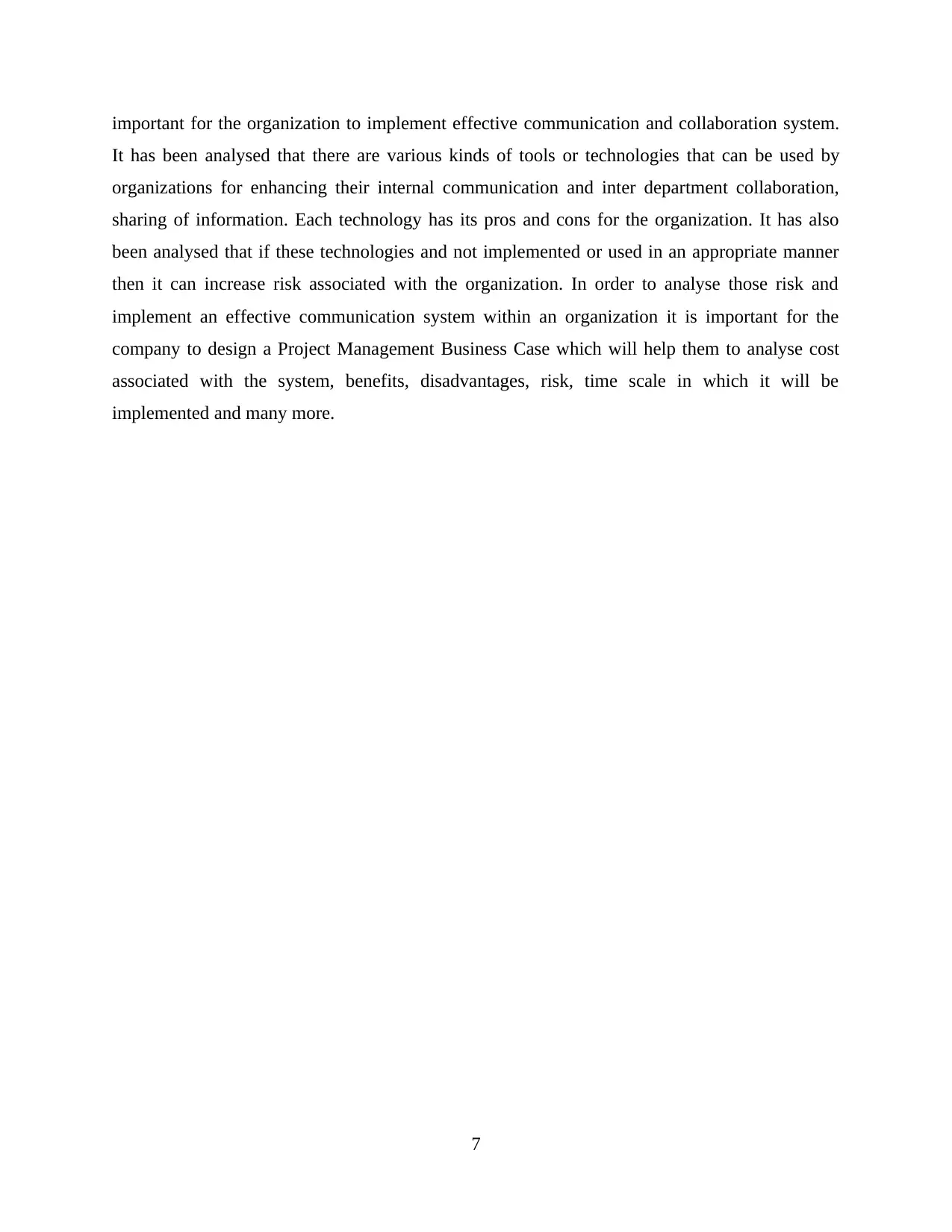
important for the organization to implement effective communication and collaboration system.
It has been analysed that there are various kinds of tools or technologies that can be used by
organizations for enhancing their internal communication and inter department collaboration,
sharing of information. Each technology has its pros and cons for the organization. It has also
been analysed that if these technologies and not implemented or used in an appropriate manner
then it can increase risk associated with the organization. In order to analyse those risk and
implement an effective communication system within an organization it is important for the
company to design a Project Management Business Case which will help them to analyse cost
associated with the system, benefits, disadvantages, risk, time scale in which it will be
implemented and many more.
7
It has been analysed that there are various kinds of tools or technologies that can be used by
organizations for enhancing their internal communication and inter department collaboration,
sharing of information. Each technology has its pros and cons for the organization. It has also
been analysed that if these technologies and not implemented or used in an appropriate manner
then it can increase risk associated with the organization. In order to analyse those risk and
implement an effective communication system within an organization it is important for the
company to design a Project Management Business Case which will help them to analyse cost
associated with the system, benefits, disadvantages, risk, time scale in which it will be
implemented and many more.
7
⊘ This is a preview!⊘
Do you want full access?
Subscribe today to unlock all pages.

Trusted by 1+ million students worldwide
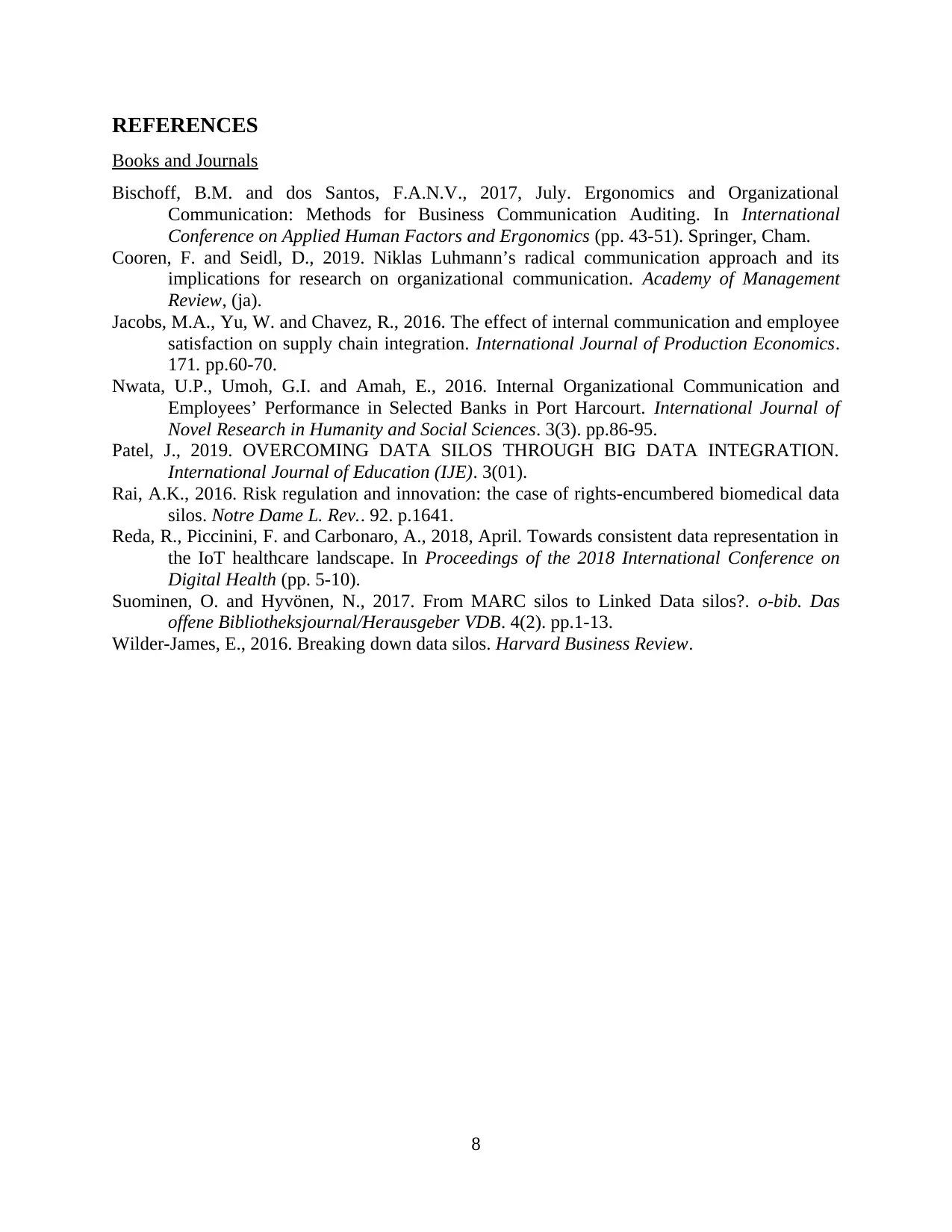
REFERENCES
Books and Journals
Bischoff, B.M. and dos Santos, F.A.N.V., 2017, July. Ergonomics and Organizational
Communication: Methods for Business Communication Auditing. In International
Conference on Applied Human Factors and Ergonomics (pp. 43-51). Springer, Cham.
Cooren, F. and Seidl, D., 2019. Niklas Luhmann’s radical communication approach and its
implications for research on organizational communication. Academy of Management
Review, (ja).
Jacobs, M.A., Yu, W. and Chavez, R., 2016. The effect of internal communication and employee
satisfaction on supply chain integration. International Journal of Production Economics.
171. pp.60-70.
Nwata, U.P., Umoh, G.I. and Amah, E., 2016. Internal Organizational Communication and
Employees’ Performance in Selected Banks in Port Harcourt. International Journal of
Novel Research in Humanity and Social Sciences. 3(3). pp.86-95.
Patel, J., 2019. OVERCOMING DATA SILOS THROUGH BIG DATA INTEGRATION.
International Journal of Education (IJE). 3(01).
Rai, A.K., 2016. Risk regulation and innovation: the case of rights-encumbered biomedical data
silos. Notre Dame L. Rev.. 92. p.1641.
Reda, R., Piccinini, F. and Carbonaro, A., 2018, April. Towards consistent data representation in
the IoT healthcare landscape. In Proceedings of the 2018 International Conference on
Digital Health (pp. 5-10).
Suominen, O. and Hyvönen, N., 2017. From MARC silos to Linked Data silos?. o-bib. Das
offene Bibliotheksjournal/Herausgeber VDB. 4(2). pp.1-13.
Wilder-James, E., 2016. Breaking down data silos. Harvard Business Review.
8
Books and Journals
Bischoff, B.M. and dos Santos, F.A.N.V., 2017, July. Ergonomics and Organizational
Communication: Methods for Business Communication Auditing. In International
Conference on Applied Human Factors and Ergonomics (pp. 43-51). Springer, Cham.
Cooren, F. and Seidl, D., 2019. Niklas Luhmann’s radical communication approach and its
implications for research on organizational communication. Academy of Management
Review, (ja).
Jacobs, M.A., Yu, W. and Chavez, R., 2016. The effect of internal communication and employee
satisfaction on supply chain integration. International Journal of Production Economics.
171. pp.60-70.
Nwata, U.P., Umoh, G.I. and Amah, E., 2016. Internal Organizational Communication and
Employees’ Performance in Selected Banks in Port Harcourt. International Journal of
Novel Research in Humanity and Social Sciences. 3(3). pp.86-95.
Patel, J., 2019. OVERCOMING DATA SILOS THROUGH BIG DATA INTEGRATION.
International Journal of Education (IJE). 3(01).
Rai, A.K., 2016. Risk regulation and innovation: the case of rights-encumbered biomedical data
silos. Notre Dame L. Rev.. 92. p.1641.
Reda, R., Piccinini, F. and Carbonaro, A., 2018, April. Towards consistent data representation in
the IoT healthcare landscape. In Proceedings of the 2018 International Conference on
Digital Health (pp. 5-10).
Suominen, O. and Hyvönen, N., 2017. From MARC silos to Linked Data silos?. o-bib. Das
offene Bibliotheksjournal/Herausgeber VDB. 4(2). pp.1-13.
Wilder-James, E., 2016. Breaking down data silos. Harvard Business Review.
8
1 out of 10
Related Documents
Your All-in-One AI-Powered Toolkit for Academic Success.
+13062052269
info@desklib.com
Available 24*7 on WhatsApp / Email
![[object Object]](/_next/static/media/star-bottom.7253800d.svg)
Unlock your academic potential
Copyright © 2020–2025 A2Z Services. All Rights Reserved. Developed and managed by ZUCOL.




